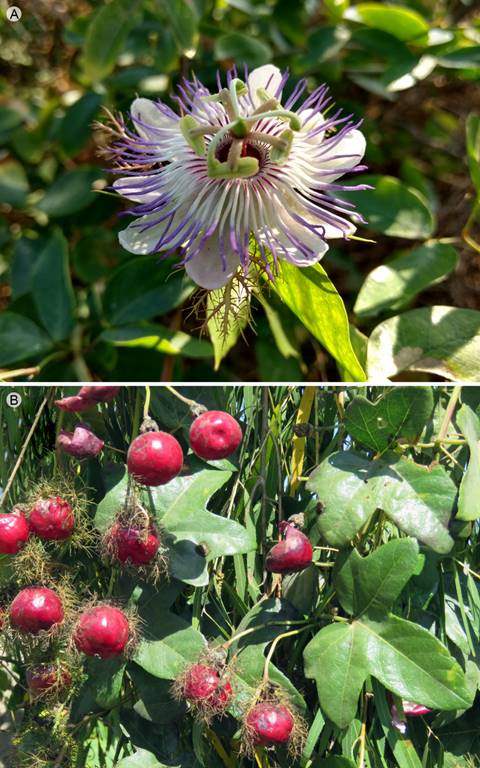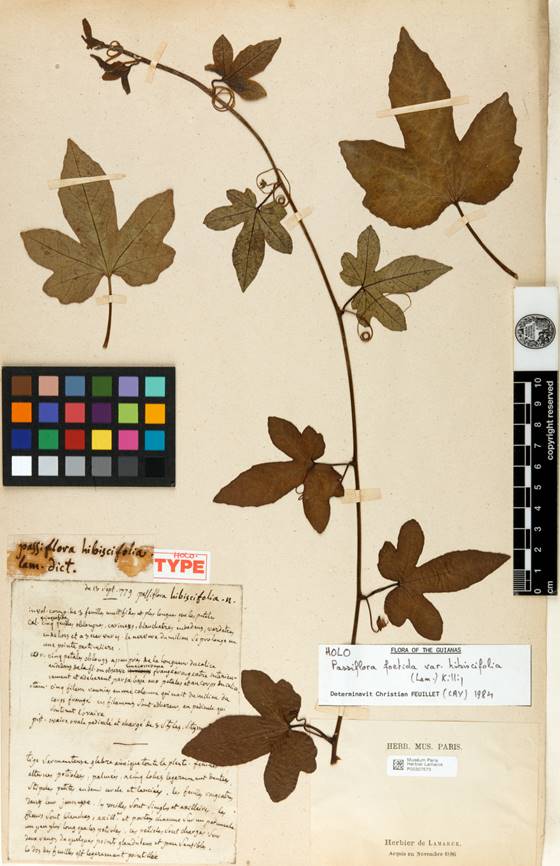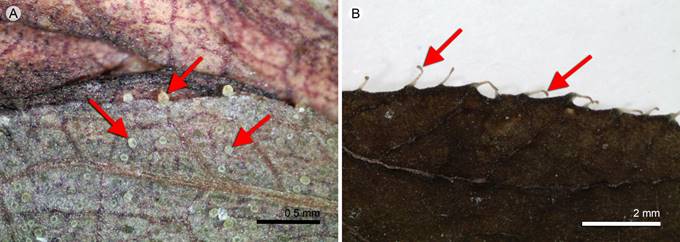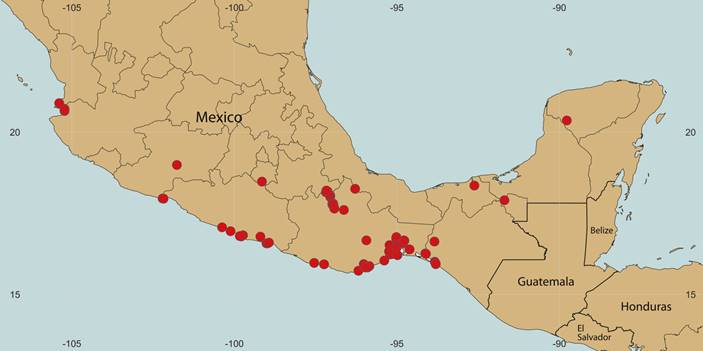Introduction
Passionflowers (Passiflora L., Passifloraceae) are an easily recognizable group due to their many, and often striking, morphological features. The genus is represented in the New World tropics by at least 580 recognized species (Ocampo Pérez and Coppens d’Eeckenbrugge, 2017) with potentially many more undescribed. Section Dysosmia DC., one of the infrageneric groups accepted by Feuillet and MacDougal (2003) in subgenus Passiflora supersection Stipulata Feuillet & J.M. MacDougal, is among the most widespread and taxonomically complicated in the genus and can be found from the southern United States of America through Argentina and throughout the West Indies. Mexico is a hotspot of diversity within section Dysosmia, which harbors 12 of the 30 taxa currently recognized in the section (Vanderplank, 2013) including two major species complexes: Passiflora ciliata Aiton and P. foetida L.
Like other members of supersection Stipulata, and subgenus Passiflora more generally, section Dysosmia has showy flowers, large involucral bracts, and conspicuous stipules. Unique to the section, however, are a suite of characters that are found nowhere else in the genus, including highly divided bracts and stipules and ubiquitous glands across the vegetative features. The latter are responsible for the often fetid or pungent smell associated with many of the taxa that belong to this section. These features may indeed represent synapomorphies for the section, but no phylogenetic studies to date have focused on Dysosmia in its entirety or aimed to test the assumptions of monophyly.
One of the oldest names attributed to section Dysosmia, Passiflora hibiscifolia Lam. (Fig. 1), was first described in 1789 by Jean-Baptiste Lamarck from material cultivated at the Jardin des Plantes (“Jardin du Roi”) in Paris, France.

Figure 1: Passiflora hibiscifolia Lam. (≡ P. ciliata Aiton var. hibiscifolia (Lam.) Vanderpl.), A. flower (photo by Diana Fuentes); B. leaves and mature fruits (photo by Alexis López Hernández).
Lamarck (1789) believed that the material for this plant originated in South America, but Killip (1938) surmised its origin to be somewhere in Central America based on the distribution inferred from herbarium collections known at the time. Subsequent taxonomic combinations based on this basionym (see Taxonomy below) have shuffled the rank and specific affinity of the taxon from a species of Passiflora, to that of a segregate genus, Dysosmia (DC.) M. Roem. (Roemer, 1846), to a variety of P. foetida (Killip, 1938). In his synopsis of the section, Vanderplank (2013) recognized the taxon as P. ciliata var. hibiscifolia (Lam.) Vanderpl., largely on account of its glabrous leaves (as P. ciliata (sensu lato) has), and is the currently accepted name.
Several other taxa with gross morphological similarities to P. ciliata var. hibiscifolia are found throughout Mexico and Central America, including P. liebmannii Mast. While this particular name has been synonymized with the taxon of interest in the past (Killip, 1938; Vanderplank, 2013), other names have not been critically investigated in this manner. Furthermore, while the taxon’s glabrous vegetative features and red fruit clearly ally this taxon with P. ciliata (sensu lato), the taxonomic affinity between the two has remained unclear.
The objective of this study is to evaluate the biological distinctness of the organism currently known as P. ciliata var. hibiscifolia and provide evidence for its taxonomic recognition.
Materials and Methods
A total of 217 herbarium specimens, including the holotype of Passiflora hibiscifolia (Fig. 2), and 27 verified iNaturalist observations (iNaturalist Network, 2018) were examined for this study. In addition, type material for several other morphologically similar taxa was also investigated: P. foetida var. maxonii Killip, P. foetida var. nicaraguensis Killip, P. foetida var. subpalmata Killip, P. liebmannii, and the current parent taxon, P. ciliata.

Figure 2: Holotype specimen of Passiflora hibiscifolia Lam. (P-P00307573), available from Muséum National d’Histoire Naturelle (MNHN, 2018).
The herbaria consulted were ASU, B, C, DUKE, E, F, IND, LINN, MEXU, MO, NY, P, RSA, TEX-LL, and US (codes follow Thiers, 2018). Coordinates from these observations were curated and mapped using SimpleMappr.net (Shorthouse, 2010). All examinations were made using an Olympus SZ61 stereomicroscope (Olympus, Center Valley, USA) and micrographs were taken with an Olympus SC30 camera (Olympus, Center Valley, USA).
Results and Discussion
Intensive morphological investigations revealed that the taxon currently recognized as Passiflora ciliata var. hibiscifolia possesses a suite of traits that are absolutely unique to the entity (Table 1).
Table 1: Comparison of Passiflora hibiscifolia Lam. with other morphologically similar taxa.
| Trait | Passiflora hibiscifolia Lam. | P. ciliata Aiton (sensu stricto) | P. foetida L. var. maxonii Killip | P. foetida L. var. nicaraguensis Killip | P. foetida L. var. subpalmata Killip |
| Stem pubescence | Glabrous | Glabrous | Pilosulous | Glabrous | Glabrous |
| Stipules | Glabrous | Glabrous | Pubescent | Glabrous | Pubescent |
| Foliar pubescence | Glabrous | Glabrous | Pilosulous | Glabrous | Hirsutulous |
| Leaf lobing | 3-5 lobed | 3- to sub 5-lobed | 3-5 lobed | 3-lobed | 3-5 lobed |
| Foliar glands | Lepidote, spheroidal | Capitate long-stipitate (margins only) | Pyriform long-stipitate | Capitate long-stipitate (margins only) | Pyriform long-stipitate |
| Leaf margins | Entire to sparingly crenate | Coarsely dentate to ciliate | Ciliate | Ciliate | Ciliate |
| Involucral bracts | Bi- to tripinnatisect | Bi- to tripinnatisect | Bi- to tripinnatisect | Bi- to tripinnatisect | Bipinnatisect |
| Perianth color | Lavender | Pink-white | “Pale purple” | Pink-white | Unknown |
| Fruit color | Red | Red | Red | Red | Unknown |
Among the most distinguishable traits are ubiquitous spheroidal, lepidote glands (Fig. 3) on the abaxial surface of the leaves which are always glabrous and deeply 3-5-lobed.

Figure 3: A comparison of some Passiflora L. gland types. A. lepidote glands (arrows) of Passiflora hibiscifolia Lam. (MacDougal 314, DUKE); B. capitate long-stipitate glands (arrows) of P. ciliata Aiton (sensu stricto) (Britton 2880, NY).
The suite of exclusive and consistent micro- and macromorphological traits indicate that this taxon is distinct from all other members of section Dysosmia, including the species to which it is currently assigned, P. ciliata (sensu stricto). On account of this evidence, and following the guidance of the Unified Species Concept (de Queiroz, 2007), this taxon deserves recognition at the rank of species as Passiflora hibiscifolia.
Passiflora hibiscifolia is easily recognizable by its unique morphological features and is the most regularly encountered Dysosmia taxon in the state of Oaxaca (Mexico). Confirmed individuals of this taxon are also found in the Mexican states of Chiapas, Guerrero, Jalisco, Michoacán, Morelos, Nayarit, Puebla, Tabasco, and Yucatán (Fig. 4).

Figure 4: The known distribution (circles) of Passiflora hibiscifolia Lam. based on confirmed herbarium specimens and iNaturalist observations. Map rendered using SimpleMappr.net (Shorthouse, 2010).
One of these collections from the state of Puebla, Liebmann 4078 collected in 1842, became the basis for Masters’ Passiflora liebmannii (Masters, 1872) but unequivocally represents P. hibiscifolia based on the uncommon traits that they share. The name Passiflora hibiscifolia, though, has priority over P. liebmannii in accordance with Article 11 of the current International Code of Nomenclature (Turland et al., 2018).
This species is clearly closely related to P. ciliata based on the glabrous vegetative features and red fruit but differs in several ways, namely the lepidote foliar glands, the lavender perianth, deep purple coronal filaments, and the entire to sparingly crenate leaf margins in P. hibiscifolia. By comparison, P. ciliata (sensu stricto) has capitate long-stipitate foliar glands (restricted to the margins), a pink-white perianth, magenta corona filaments, and often coarsely dentate or ciliate leaf margins. The suite of traits of the latter species are also found in another taxon, P. foetida var. nicaraguensis, and likely represents the same organism (Svoboda, 2018).
Other taxa, namely P. foetida var. maxonii and P. foetida var. subpalmata, appear similar based on gross vegetative morphology but differ in having pubescent leaves and pyriform long-stipitate glands. Vanderplank (2013) included several pubescent specimens in his circumscription of P. hibiscifolia (as P. ciliata var. hibiscifolia), but this is in direct conflict with the protologue and type specimen which both indisputably represent a completely glabrous plant. Therefore, this name is confined to glabrous specimens with the morphological features mentioned above.
Taxonomy
Passiflora hibiscifolia Lam., Encycl. 3(1): 39. 1789. TYPE: FRANCE. Île-de-France, department of Paris, cultivated at the Jardin des Plantes (“Jardin du Roi”), Paris, original material presumably from Mexico, 13.IX.1779, J.-B. Lamarck s.n. (holotype: P!).
≡ Dysosmia hibiscifolia (Lam.) M. Roem., Fam. Nat. Syn. Monogr. 2(2): 149. 1846.
= Passiflora liebmannii Mast., Fl. Bras. 13(1): 547. 1872. TYPE: MEXICO. Puebla, municipality Coxcatlán, Venta Salada, V.1842, F. M. Liebmann 4078 (Passiflorea 41) (holotype: C!, isotype: US!).
≡ Passiflora foetida L. var. hibiscifolia (Lam.) Killip, Publ. Field Mus. Nat. Hist., Bot. Ser. 19: 507. 1938.
≡ Passiflora ciliata Aiton var. hibiscifolia (Lam.) Vanderpl., Bot. Mag. 30(4): 358. 2013.
Plant completely glabrous throughout; stems terete; stipules deeply divided with pyriform long-stipitate glands; petioles with few short-stalked glands; leaves deeply 3-lobed when immature, developing 5(-7) lobes at maturity, 5-10 cm wide, 4-8 cm long, margins entire to sparingly crenate, bearing short-stalked obconical glands, abaxial surface with spheroidal, lepidote glands; involucral bracts bi- to tripinnatisect, the ultimate segments gland-tipped; flowers lavender-white, 3.5-4.5 cm in diameter, sepals ovate-lanceolate, awned, petals oblong-lanceolate; corona in 5 series, the outermost magenta (inner fourth) and purple (outer third) with white between (Fig. 1A); androgynophore mostly red; ovary ovoid; fruits globose, deep red at maturity (Fig. 1B); seeds oblong, punctate, black-brown at maturity.
Distribution: found throughout southern Mexico, with a concentration in the state of Oaxaca (Fig. 4).
Habitat: most commonly in coastal dunes, secondary forest edges, sandy roadsides, and dry stream beds. Elevation 0 to 1069 m (273 m average).
Phenology: budding, flowering, and fruiting year-round.
Additional specimens examined: HONDURAS. Atlántida, unknown municipality, La Fragua, 20 m, 7.XII.1927, P. C. Standley 52665 (type of Passiflora foetida var. nicaraguensis; F, US). MEXICO. Chiapas, municipality Chiapilla, hwy 190 between Tehuantepec and Tuxtla Gutiérrez, Central Depression region, 18.V.1995, K. Gould and J. Williams 138 (TEX); 50 km al SE de Tuxtla Gutiérrez, camino a La Angostura, 630 m, 21.IV.1987, E. Martínez S. and A. Reyes G. 20194 (MEXU, RSA, TEX). Municipality Cintalapa, near Comitancillo, 11.I.1945, E. J. Alexander 314 (NY). Municipality Ocozocoautla de Espinosa, 10 km E de La Ventosa, 21.XI.1984, O. Téllez V. et al. 8163 (MEXU). Municipality Tonalá, NW of Puerto Arista, 3 m, 22.VI.1972, D. E. Breedlove 25574 (MEXU, MO); loc. cit., 19.X.1972, D. E. Breedlove and R. F. Thorne 20852 (MEXU, MO, NY); Puerto Arista, 2.VI.1964, R. Lent 1 (MO). Guerrero, municipality Acapulco de Juárez, N of Pie de la Cuesta, NW of Acapulco, 5.I.1944, F. A. Barkley 14171 (BRIT, MEXU, MO, NY, RSA, TEX); Viveros El Huayacán, La Poza, 22.V.1979, W. L. Forment 763 (MEXU), 767 (MEXU); terreno al O de Viveros El Huayacán, La Poza, 28.VIII.1980, W. L. Forment 1140 (MEXU); San Pedro de las Playas, orilla de la Laguna de Tres Palos, 1 m, 6.VII.1966, D. García S. s.n. (MEXU); Isla de la Rogusta, Acapulco, V.1951, D. Ramírez C. s.n. (MEXU); Puerto Marqués, Acapulco, IX.1952, D. Ramírez C. s.n. (MEXU); 3 km SE de Puerto Marqués, 10 m, 28.V.1986, J. C. Soto N. and F. Solórzano G. 12856 (MEXU). Municipality Arcelia, lower Barranca de la Guacamaya, 27.XI.1937, Y. Mexia 8911 (B, US). Municipality Copala, 64 km E of San Marcos on hwy 200, 17.VII.1993, D. Seigler et al. 13919 (MEXU). Municipality Coyuca de Benítez, cerca de la barra, Laguna Matilda, 2 m, 28.III.1984, G. Espinosa 89 (MEXU); Boca de Mitla, Laguna de Mitla, 5 m, 30.VIII.1984, L. Lozada P. 2 (MEXU); Isla Magueyes, 4 m, 30.X.1984, L. Lozada P. 194 (MEXU); El Dorado II, Laguna de Mitla, 0 m, 5.III.1984, L. Lozada P. 331 (MEXU); Boca de Mitla, Laguna de Mitla, 1 m, 7.VII.1985, L. Lozada P. 515 (MEXU). Municipality Cruz Grande, brecha a Playa del Sol, 5 km NE de La Huacana, 30.IV.1982, E. Martínez S. and J. Villaseñor 475 (MEXU, MO). Michoacán, municipality La Huacana, camino revestido a 80 km E de Acapulco, en la carretera Acapulco Pinotepa Nacional, 23.III.1982, E. Martínez S. and O. Téllez 110 (DUKE). Oaxaca, district Cuicatlán, municipality Cuicatlán, 550 m, 24.III.1920, C. Conzatti 3911 (MEXU). Municipality San Juan Bautista Cuicatlán, Papala to Cuyamecalco, 1000 m, XII.1945, G. Aguirre B. 12 (NY); Río de San José El Chilar, 627 m, 17.73278°, -96.94278°, 26.X.2001, C. A. Cruz-Espinosa and E. San Pedro 659 (MEXU); 3 km N de San José El Chilar, orilla del Río Chilar, 700 m, 17.68528°, -96.93639°, 10.X.2002, C. A. Cruz-Espinosa and E. San Pedro 1511 (MEXU); Cuicatlán, 610 m, 17.79944°, -96.96453°, 23.XII.1940, F. A. Miranda-González 979 (MEXU); barranca del Río Chico, E de (San Juan Bautista) Cuicatlán, 14.IX.1948, F. A. Miranda-González 4621 (MEXU); vicinity of Cuicatlán, 8-24.X.1894, E. W. Nelson 1632 (US); near Tomellín, 4-5.IX.1905, J. N. Rose et al. 10056 (US); 1 km O de Dominguillo, 750 m, 18.IV.1987, A. Salinas T. and C. H. Ramos F-3978B (RSA); 1.5 km O de Dominguillo, 750 m, 18.05°, -97.05°, 1.VII.1987, A. Salinas T. et al. 4160 (MEXU, MO). Municipality Valerio Trujano, Valerio Trujano, a orillas del Río Apoala, 692 m, 17.76942°, -96.98417°, 16.X.2004, G. Juárez G. and F. Marini 608 (MEXU); 1.5 km O de Tomellín, 1000 m, 18.05°, -97.05°, 30.VI.1987, A. Salinas T. et al. 4143 (MEXU). District Ixtlán, municipality San Juan Quiotepec, Río de Quiotepec, 18.XII.2004, C. A. Cruz-Espinosa 2185 (MEXU). District Juchitán, municipality Asunción Ixtaltepec, hacia el Agua Tibia, 500 m en línea recta al N de Nizanda, 11 m, 16.66722°, -95.00972°, 22.VII.1999, J. M. del Castillo 2288 (MEXU); 3 km NO de Chivela, 16.XI.1982, R. Cedillo T. and R. Torres C. 1067 (LL, MEXU, MO). Municipality Juchitán de Zaragoza, 11 km NE de Juchitán hacia La Ventosa, 30 m, 16.5275°, -94.96194444°, 10.VI.2002, L. Alvarado C. et al. 63 (MEXU); 13 km al NE de Juchitán (de Zaragoza), carretera a La Ventosa, 24.V.1982, R. Cedillo T. et al. 1362 (LL, MEXU, MO); 0.5 mi E of Río de los Perros in Saltillo, VII.1980, C. Greene 8027 (IND); ejido La Ventosa Mojonera San Carlos, a orilla de la carretera panamericana, entre la Venta y la Ventosa, 38 m, 16.57236°, -94.87633°, 21.II.2007, A. Nava Z. et al. 1911 (MEXU). Municipality Matías Romero, 14 km S de Matías Romero en la carretera Transístmica, 100 m, 22.II.1978, M. Sousa et al. 9194 (MEXU). Municipality San Francisco del Mar, el rancho Faja de Oro, 5.4 km en línea recta, al NW de Montecillo Santa Cruz, 10 m, 16.39083°, -94.61194°, 27.XI.2001, A. Franco et al. 21 (MEXU); el rancho Faja de Oro, 3.75 km en línea recta al NW de Montecillo Santa Cruz, 10 m, 16.3875°, -94.60861°, 28.X.2001, K. F. Martínez et al. 51 (MEXU). Municipality San Miguel Chimalapa, 2 km SE de Vista Hermosa, hacia San Miguel Chimalapa, 13.III.1982, R. Torres C. and R. Cedillo T. 108 (DUKE, MEXU, MO, NY). Municipality of San Pedro Tapanatepec, 5 mi N of Oaxaca - Chiapas line, ca. 10 mi S of jct. of rte 200 and 190 (along rte 200), 16.25222°, -94.10639°, 17.VII.1971, D. L. Spellman 2103 (MO), 2104 (MO), 2106 (MEXU, MO), 2108 (MEXU, MO), 2109 (MO). Municipality Santiago Niltepec, along an irrigation canal off hwy 190, 60 mi E of Tehuantepec, 20.VII.1978, M. Pennel et al. 206 (MEXU, MO). District Juquila, municipality Santa Catarina Juquila, 17.VII.1910, H. H. Rusby 48 (NY, US). District Pochutla, municipality San Miguel del Puerto, Zimatán, 2 km N del puente, por la brecha a Xadani, 80 m, 15.875°, -96.00528°, 6.III.2000, M. Elorsa C. 2772 (MEXU). District Tehuantepec, municipality Magdalena Tlacotepec, 7 km NW de la entrada a Tlacotepec, 474 m, 16.51983965°, -95.2253161°, 26.IX.1984, E. Cabrera C. and H. de Cabrera 7363 (MEXU). Municipality San Mateo del Mar, San Mateo del Mar, 5 m, 11.I.1978, D. Zizumbo and P. Colunga 67 (MEXU, MO). Municipality San Pedro Huamelula, Playa Grande, 0.5 km N de la playa por el Arroyo Playa Grande, 5 m, 15.84472°, -95.90694°, 25.XI.1998, M. Elorsa C. 1157 (MEXU); 1 km N de Playa Grande, 40 m, 15.83417°, -95.89778°, 28.I.1999, M. Elorsa C. 1567 (MEXU); Playa Grande, 1 km N, 25 m, 15.85056°, -95.90361°, 11.I.2000, M. Elorsa C. 2647 (MEXU, MO); 1.5 km N de Playa Grande, sobre La Brecha, 40 m, 15.85417°, -95.90306°, 22.IV.1999, C. Perret et al. 310 (MEXU); Mascalaco, camino hacia la Laguna, 300 m W de Rancho Paraíso, 30 m, 15.87389°, -95.84639°, 12.IV.1997, J. Rivera H. et al. 382 (MEXU). Municipality Santa María Guienagati, La Chiviza, 3 km S de la Ollaga, 16.III.1983, R. Torres C. et al. 2561 (MEXU, MO). Municipality Santiago Astata, Barra de la Cruz, 2 km SE de camino hacia el campamento tortuguero, 5 m, 30.IV.1998, M. Elorsa C. 187 (MEXU); Barra de la Cruz, 25.5 km E de Laguna la Agüita y Cerro Pelón, 5 m, 22.I.1999, M. Elorsa C. 1530 (MEXU); 4 km E de Arroyo Jicara, 10 m, 3.II.1999, M. Elorsa C. 1627 (MEXU); Zimatán, 4 km SSE del puente, por la bocana del río, 15 m, 6.II.1999, M. Elorsa C. 1661 (MEXU); 1.6 km NO a la desviación de la carretera de Costera, 110 m, 17.III.1999, M. Elorsa C. 1926 (MEXU); 2.5 km SO de Río Viejo Zimatán, 45 m, 23.III.1999, M. Elorsa C. 1962 (MEXU); 2 km SE de camino hacia el campamento tortuguero, 5 m, 5.IV.1999, M. Elorsa C.1982 (MEXU); 6 km SE por La Agüita, 10 m, 8.II.2002, M. Elorsa C. 2707 (MEXU); 1.5 km SE de Laguna del Cerrito, 0 m, 21.XII.1998, S. Salas M. 1910 (MEXU). Municipality Santo Domingo Tehuantepec, km 15 de la carretera Tehuantepec a Juchitán (de Zaragoza), 25.II.1981, R. Cedillo T. 562 (MEXU, NY); Ensenada Chipehua, 37 km SO de Salina Cruz, 3.V.1980, S. González O. 334 (MEXU); Buenos Aires on gravel road off hwy 190, ca. 15 km E of Tehuantepec, Isthmus of Tehuantepec, 17.V.1995, K. Gould and J. Williams 137 (TEX); 1.8 mi off hwy 190, 9 mi E of jct with hwy 185, 22.VII.1976, L. Hess et al. 1265 (ASU, MEXU, MO, NY); 9-10 km E of the village of La Ventosa, along the Pan-American highway (rte 190), 50 m, 16.VII.1959, R. M. King 1686 (NY, TEX, US); Salina Cruz, La Ventosa, 27.VII.1978, J. M. MacDougal 314 (DUKE, US); Tehuantepec, 28.III.1970, T. MacDougall 25.S (NY); loc. cit., XII.1964, T. MacDougall s.n. (NY); loc. cit., 31.V.1964, T. MacDougall s.n. (NY); (San Pedro) Huilotepec, 4-11.V.1895, E. W. Nelson 2589 (US); Tehuantepec, 2.VI.1910, C. R. Orcutt 5272 (US); Tehuantepec, cerco de una casa, 20.II.1975, G. Shapiro 3 (MEXU); 7 mi S of jct. of rte 185 and 190, 16.4580556°, -94.9994444°, 17.VII.1971, D. L. Spellman 2110 (MEXU), 2111 (MO), 2112 (MO), 2116 (MO), 2117 (MO). District Teotitlán, municipality San Antonio Nanahuatipam, cerro Nahualtepec, 3 km O de San Gabriel, por la terracería rumbo a Axusco, 1050 m, 18.15°, -97.183333°, 16.IV.1987, A. Salinas T. and C. H. Ramos F-3880 (MEXU, RSA, US); Cañada Bandera al SE de San Antonio Nanahuatipam, 900 m, 28.V.1985, P. Tenorio L. et al. 8861 (MEXU, US). Municipality San Juan de los Cués, 3.5 km from San Juan de los Cués on gravel road, 575 m, 18.005°, -97.05083°, 9.V.2001, J. I. Calzada and M. Paredes F. 22981 (MEXU). Municipality San Martín Toxpalan, 15 mi past border on rte 135 from Tehuacán to Oaxaca, 650 m, 18.0833333°, -97.08333°, 15.VII.1990, J. A. Soule and D. R. Brunner 2249 (MEXU, MO, TEX). District Tlacolula, municipality San Pedro Totolápam, 24 mi E of (San Pedro) Totolápam, 2400 m, 12.VIII.1962, G. L. Webster et al. 12996 (GH, MEXU, MO). District Tuxtepec, municipality Cosolapa, 6 km N de Las Margaritas, rumbo a San Luis del Río, 820 m, 16.X.1987, S. Acosta C. 788 (MEXU). Unknown municipality, estación San Antonio, 800 m, 13.XII.1907, C. Conzatti and C. Conzatti 2111 (MEXU); San Antonio, 762 m, 2.IX.1894, C. G. Pringle 4847 (E, MEXU, MO, NY, P, RSA, US); 10.I.1896, E. Seler 1665 (NY); San Antonio valley, 792 m, 1.IX.1894, C. L. Smith 245 (MO, RSA, US). Puebla, municipality Coxcatlán, rte 131, 1 mi N of Tlapa, 853 m, 20.VII.1978, J. M. MacDougal 285 (DUKE, US); 12 km SE de Coxcatlán, sobre la carretera a Teotitlán (de Flores Magón) on hwy 980, 31.III.1968, J. Rzedowski 25576 (MEXU); Río Salado, SO de Pueblo Nuevo, 1020 m, 22.V.1991, P. Tenorio L. and E. Martínez C. 17380 (MEXU). Municipality Tehuacán, Tehuacán, VI.1841, F. M. Liebmann 4079 (US). Tabasco, municipality Centla, Lagunas Pajaral I, II, 20 km S de Frontera, laguna que desemboca a Río San Pedrito, 7 m, 18.35445°, -92.615833°, 8.VII.1998, A. Novelo R. and L. Ramos V. 2702 (MO). Municipality Emiliano Zapata, 32 km SE de Blanca, 11 km NE de El Chable, 10.V.1982, E. Cabrera C. et al. 2660 (DUKE, MEXU, MO). Yucatán, municipality Progreso, Progreso, open place, 11-15.VIII.1932, W. C. Steere 3022 (type of Passiflora foetida var. subpalmata; US). Municipality Santa Elena, Uxmal, 3.I.1977, W. Schwabe s.n. (MEXU). NICARAGUA. Managua, municipality Managua, vicinity of Managua, mostly along the shore of Lake Managua, 24.VI.1923, W. R. Maxon 7219 (type of Passiflora foetida var. maxonii; US). UNITED KINGDOM. England, county of Oxfordshire, Honorable Mrs. Barrington’s stove at Mongewell, VII.1791, (original material from Jamaica), Unknown s.n. (neotype of Passiflora ciliata; LINN-HS).
iNaturalist observations examined: MEXICO. Guerrero, municipality Copala, 16.574339(, -99.011536(, 15.III.2018, H. V. Bárcenas (username: horacio_barcenas; iNaturalist ID: 10360363); 16.574585(, -98.978237(, 15.III.2018, D. Fuentes (username: dianafr; ID: 10393452). Jalisco, municipality Puerto Vallarta, 20.653407(, -105.225332(, 26.III.2017, M. C. Álvarez R. (username: cecilia_mayanjays; ID: 5874307); 20.722495(, -105.23058(, 17.I.2018, E. Canales (username: erendiracanales; ID: 9524959); 20.702344(, -105.224605(, 8.IV.2017, M. Guel A. (username: maribel_guel20; ID: 9872887); 20.653407(, -105.225332(, 17.I.2018, K. E. Peña J. (username: karenjoya; ID: 9529551). Michoacán, municipality Lázaro Cárdenas, 17.956181(, -102.208217(, 6.X.2017, W. Ostria (username: wero-ostria; ID: 8291767); 17.950494(, -102.178906(, 4.V.2017, H. Suzuki (username: hakikuchi; ID: 6096896). Morelos, municipality Tlaquiltenango, 18.477116(, -99.151407(, 7.VI.2013, username: annemirdl (ID: 325005). Nayarit, municipality Bahía de Banderas, 20.893697(, -105.389357(, 1.II.2017, A. López H. (username: alexiz; ID: 5115933). Oaxaca, district Juchitán, municipality Asunción Ixtaltepec, 16.571377(, -94.954319(, 10.V.2011, username: tereso30 (ID: 7605012). Municipality Heroica Ciudad de Juchitán de Zaragoza, 16.597207(, -94.82686(, 8.I.2007, username: tereso30 (ID: 7605025); 16.423098(, -95.016101(, 10.V.2017, A. Jossafat (username: abeljossafat; ID: 6168756); 16.574997(, -94.814415(, 22.V.2015, J. C. Pérez M. (username: charro; ID: 2663734). District Juquila, municipality Villa de Tututepec de Melchor Ocampo, 15.971396(, -97.543402(, 17.III.2018, H. V. Bárcenas (username: horacio_barcenas; ID: 10710804); 15.92873(, -97.238402(, 18.III.2018, H. V. Bárcenas (username: horacio_barcenas; ID: 10728801); 15.970324(, -97.514048(, 18.V.2018, H. V. Bárcenas (username: horacio_barcenas; ID: 12695916); 15.971833(, -97.544243(, 17.III.2018, D. Fuentes (username: dianafr; ID: 10311329); 15.929715(, -97.241989(, 18.III.2018, D. Fuentes (username: dianafr; ID: 10311694); 15.92906(, -97.239655(, 18.III.2018, D. Fuentes (username: dianafr; ID: 10408089). District Pochutla, municipality Santa María Huatulco, 15.767418(, -96.130646(, 24.VI.2018, C. Domínguez-Rodríguez (username: blakesito; ID: 13851296); 15.767322(, -96.130409(, 2.VII.2018, C. Domínguez-Rodríguez (username: blakesito; ID: 14114383); 15.767513(, -96.130516(, 3.VII.2018, C. Domínguez-Rodríguez (username: blakesito; ID: 14115527); 15.729802(, -96.184521(, 8.II.2015, J. C. Garcia M. (username: juancarlosgarciamorales1; ID: 1232027). District Tehuantepec, municipality San Pedro Huamelula, 15.840556(, -95.970833(, 5.V.2018, E. N. Tapia B. (username: momoto-erick; ID: 12537177). Municipality Santo Domingo Tehuantepec, 16.324444(, -95.238889(, 8.V.2014, J. C. Garcia M. (username: juancarlosgarciamorales1; ID: 1166121); 16.335481(, -95.235672(, 23.IV.2015, J. C. Garcia M. (username: juancarlosgarciamorales1; ID: 1418031).











 nueva página del texto (beta)
nueva página del texto (beta)



